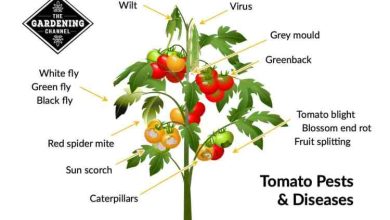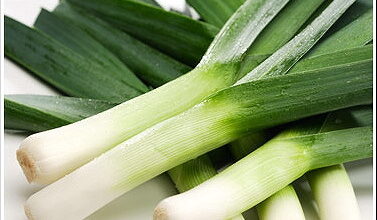Pests and Diseases of the Pistachio: Control and prevention
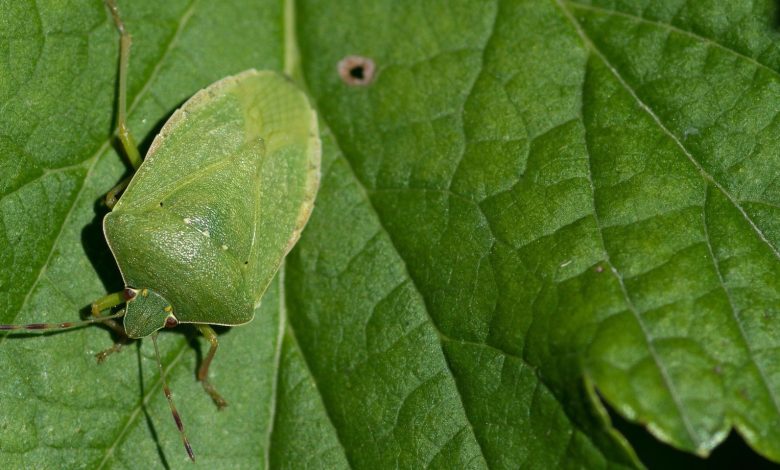
Hello farmers. In this article we are going to tell you about the main pests and diseases of the pistachio tree, better known as pistachio tree. In addition, to give you all the guidelines to eliminate and combat them.
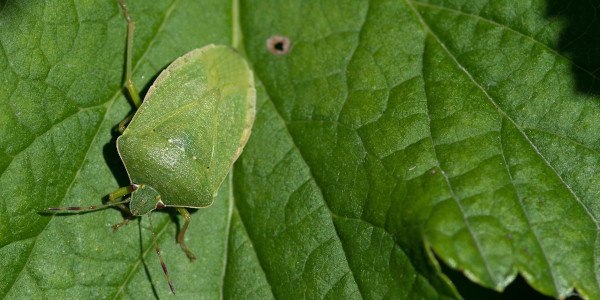
1. Peculiarities of the pistachio against pests and diseases
As you know, the right climate to grow pistachios must have long, hot and dry summers, which will reduce the appearance of pests and diseases, due to these high temperatures and low humidity.
On the other hand, and more particularly in Spain, as it is a tree that has only been cultivated for a few years, pests and diseases have not yet adapted to it, so the incidence of natural enemies is lower here than in other countries, such as Iran or the United States, where it has been cultivated for much longer and, therefore, the pest and disease problems are more serious. Although, it is true that the incidence of pests and diseases in Spanish pistachio plantations is increasing.
As a positive point, we can say that the pistachio tree is a tree of great hardiness, which means that it is capable of surviving in adverse conditions and, therefore, it is not as sensitive to pests and diseases as other fruit trees. Obviously this will not «get rid» of them but it is more resistant.
2. Pests of the pistachio tree
2.1. Green bug (Nezara viridula L.)
These hemiptera are going to cause us damage to the fruits by inserting their mouthparts to feed on the sap.
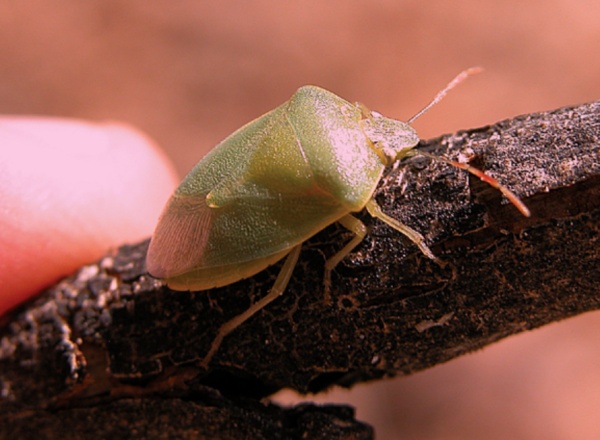
What damage does the green bug cause?
When these hemiptera feed, they leave small holes in the fruit, around which irregular black spots will appear. In addition, through these holes, the trees can contract other diseases such as the Botryosphere.
Green bug control and prevention measures
These bugs winter in the adventitious plants and dry leaves that surround the crop and, once spring arrives, they come out to feed. Therefore, it is advisable to remove these plants and leaves to prevent their appearance.
As biological control measures, natural enemies can be introduced that are parasites of their eggs, such as Trissolcus basalis and Ooencyrtus. There are also other species such as Trichopoda pennipes that is capable of parasitizing adults.
Another measure that can be used organically is paraffin oil, applied at the end of winter in a solution of 5-7 cm 3 per 10 liters of water. Garlic repellants and Neem oil can also help.
2.2. Piral or Flour Moth (Plodia interpunctella)
It is a type of Lepidoptera very common in dry fruits and whose incidence occurs mainly when the fruits are stored. Adults do not cause damage, the problem comes with the larvae. When the pistachios begin to open, the females lay their eggs in the areas where the shell has broken. Once the eggs hatch, the larvae begin to feed, leaving silky debris and damage like the ones in the image below.
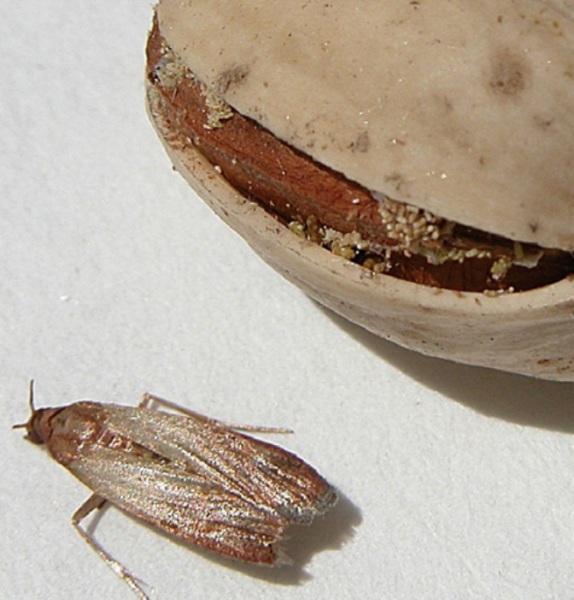
Measures of control and prevention of the flour moth
As control measures, the main thing is to maintain good ventilation in the warehouses. Adults can also be caught in sticky traps before they lay eggs. There are also parasites of the larvae of this moth such as Venturia canesces or Habrobracon hebetor, and of the eggs, such as Trichogramma pretiosum.
23. Pistachio psyllas (Agonoscena pistaciae and A. targionii)
These two species of Agonoscena are insects of the Hemiptera order, which feed by sucking the sap of pistachio trees both in the nymphal stage and in their adult stage. The females lay their eggs on the underside of the leaf during the spring, after which the eggs hatch, giving rise to nymphs.
How to identify pistachio psilas?
The highest incidence of this insect is from sprouting until after harvest. During this period we must look at the underside of the young leaves and see if there are eggs (very small yellowish dots). It may also be that the eggs have already hatched and we have nymphs, which will also be yellowish in color and can be both on the upper side and on the underside of the leaf. Another clue is that there must be traces of a cottony substance.
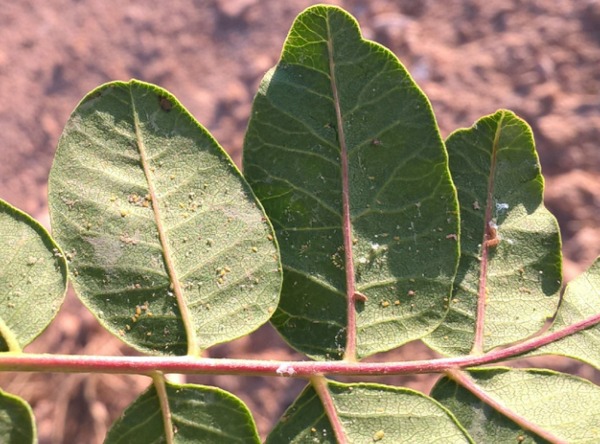
The symptoms they produce are: yellowing, rolling and necrosis of the leaves.
Pistachio psylla control and prevention measures
To prevent this type of insect, cover crops or hedges can be planted to serve as a refuge for the natural enemies of the pest, always on a non-permanent basis so that they do not compete with the pistachio and if the water and nutritional conditions allow it.
The parasitoid Psyllaephagus pistaciae wasp is the best option for biological control, although we can also include predators, such as Chrysoperla carnea, the ladybird Oenopia conglobata or the bug Antocoris nemoralis.
Within the ecological control, it would also be allowed to apply aluminum silicate, which acts as a protective film to repel these psylla from laying eggs, and paraffin oil.
2.4. Clytra or beetle (Lambidostomis lusitanica)
The clitra is a beetle that feeds on pistachio leaves, literally devouring them, even being able to leave only their central nerve. Also noteworthy is its rapid ability to feed, especially on young trees, with which it can finish in just a few hours. The period with the greatest activity of this pest is the month of May.
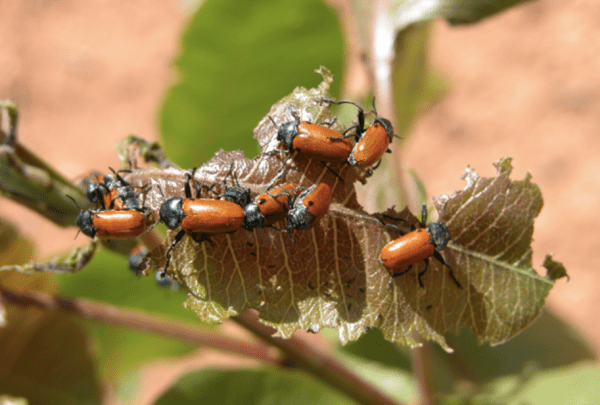
Control measures and prevention of clitra
Some plants, such as cruciferous plants, are a refuge for this beetle, so if we detect the presence of this type of plant in our plot, they should be removed immediately. To do this, we can resort to tillage in winter as a preventive measure. With this technique, in addition to eliminating these plants, we will be burying the pupae of the plague and will prevent them from coming out the following season.
In the event that the appearance of the pest is in localized areas of the plantation, we could shake the branches of the tree, covering the surrounding ground with plastic or similar, so that the adults can be easily collected when they fall.
For its ecological control, natural pyrethrins, products containing azadirachtin or garlic powder repellents can be used.
3. Pistachio diseases
3.1. verticillium wilt
Verticillium wilt is a disease caused by the fungus Verticillium dahliae K. when it penetrates the roots of the tree. It caused numerous disasters in California pistachio plantations until the arrival of resistant rootstocks such as Pistacia integerrima and the UCB1 hybrid, which we already discussed in the article on pistachio varieties and rootstock.
The pistachio tree is especially sensitive to this disease, and can end up with the plant. It is a fungus that is present in some soils, especially in those that are deep and humid, so the irrigation system will have a great influence when it comes to controlling the disease. In addition, Verticillium is capable of surviving in soil for more than 15 years even without a host to live on, which makes it much more dangerous. For this reason, it is interesting to carry out an edaphological analysis in which their presence in the soil is analyzed before starting the pistachio plantation.
What symptoms do pistachio trees affected with Verticillium have?
The fungus enters the tree almost exclusively through the roots, although, to a lesser extent, it could also access through the aerial part, for example, through a wound in the branches. This will cause a slowdown in the development of the tree and a decrease in its size.
In the first place, we will observe how the leaves of the infected branches will present a yellowing from the tip to the part closest to its union with the branch and, over time, they will dry out. These symptoms will be especially visible in June, although in some cases they can also be observed in spring.
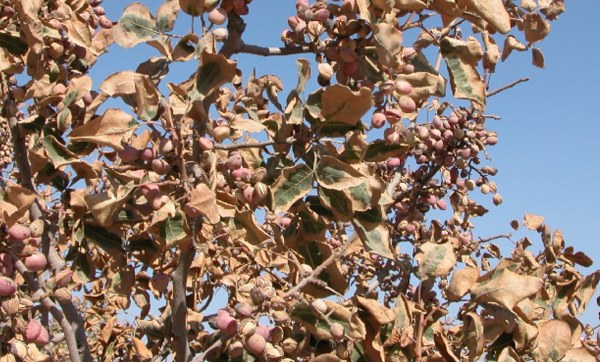
If the disease continues to progress, when making a cut in one of the main branches, we will observe something similar to what the following image shows:
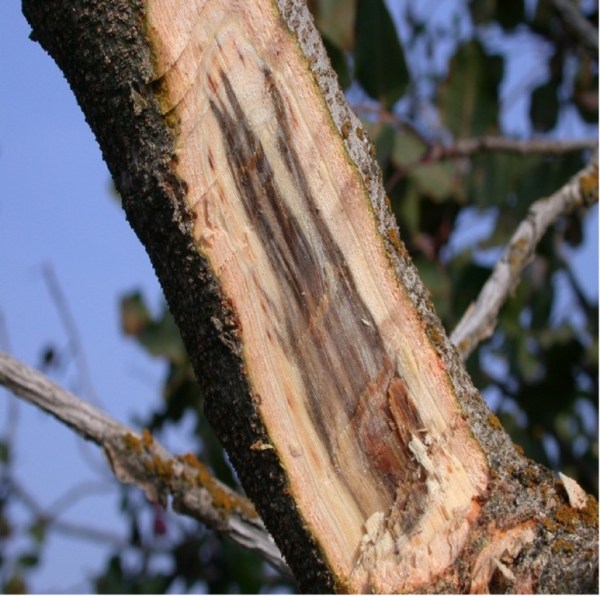
If verticillium wilt continues to progress, the pistachio tree will end up drying out completely and falling to the ground.
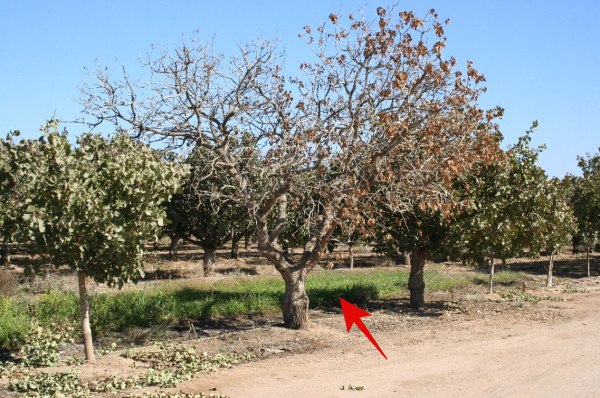
Verticillium control and prevention measures
To begin with, we will say that there is no 100% effective treatment to kill Verticillium, unlike other diseases or pests, so all practices are for the prevention or mitigation of the disease.
The most important thing is to carry out a soil analysis before starting the plantation. If our soil has Verticillium, we must opt for resistant varieties, such as Pistacia integerrima and the hybrid UCB1. For more information on how to choose the variety, take a look at our pistachio varieties and rootstock article.
As preventive measures or that contribute to not suffering verticillium wilt problems are:
- Solarization of the soil, this technique consists of covering the soil with plastic, temporarily reducing the density of the fungus, but, as we have already said, it will not disappear
- Rainfed and no-till techniques also reduce the spread
- Maintain a balanced nutrition, especially avoiding phosphorus and potassium deficiencies.
3.2. botryosphere
This disease is caused by the fungus Botryosphaeria dothidea, which spreads through the air and affects numerous plants. It normally occurs due to damage from pests such as bedbugs and its development will be greater as temperatures increase, associated with high humidity.
What symptoms do pistachio trees affected with Botryosphere have?
The mildest symptoms of this disease will appear in mid-spring, manifesting as leaf lesions and slow growth. The leaves will darken before drying and we will see how brown spots appear, to finish withering in the month of May.
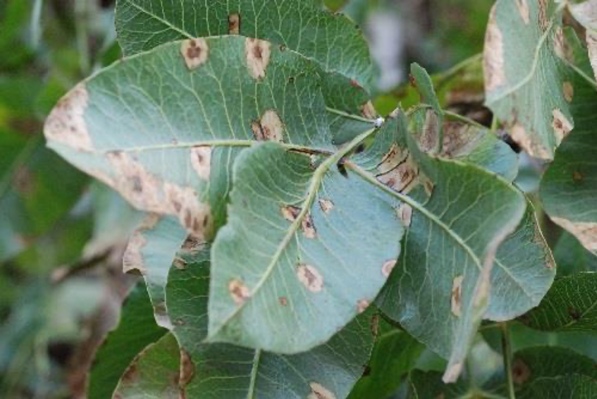
At the same time we will observe damage and darkening of the buds, like the one shown in the following image.
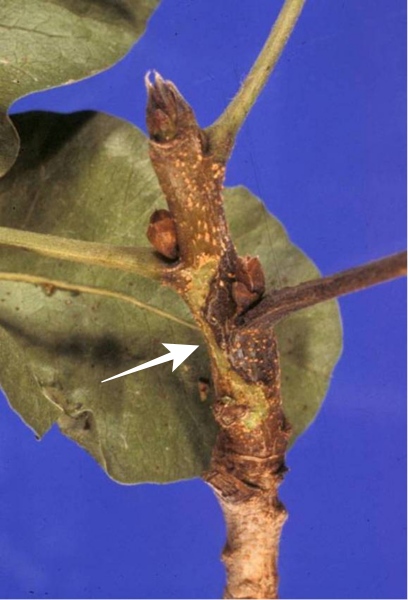
If the infection continues, in mid-summer, black dots will appear on the fruit and spread. The pistachios will start to shrivele and end up completely browned. By late summer, the tree will have lost most of its leaves.
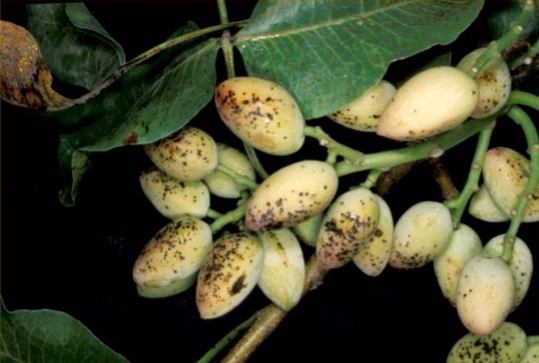
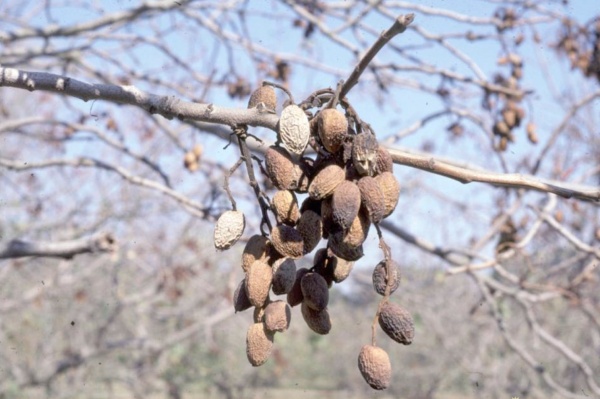
Control and prevention measures of the Botryosphere
A good way to control this disease is through selective pruning, removing debris as soon as possible to prevent the fungus from being transmitted again by spores.
Another practice is to avoid high relative humidity, for example by eliminating weeds and drip irrigation in a controlled manner, to avoid waterlogging. With the elimination of weeds, we will also be helping to prevent the appearance of hemiptera pests, such as bed bugs, which act as vectors of this disease.
In other countries, such as the United States, in the California area, the use of a biofungicide called regalia is giving good results.
3.3. alternate
It is a disease caused by the fungi Alternaria alternata, Alternaria tenuissima and Alternaria arborescens, which spread through the air. The most dangerous time for trees is from mid-summer to fall.
What symptoms do pistachio trees affected with Alternaria have?
The first symptoms will be observed on the leaves, since rounded brown or black spots will appear, these being darker in the center and lightening slightly towards the outside.
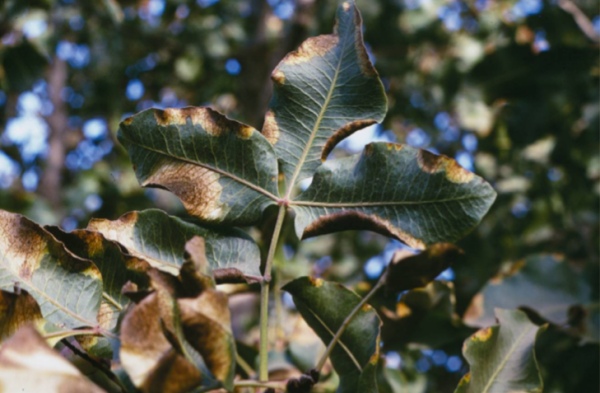
If the disease continues to progress, these spots will get bigger and bigger until they end up joining each other and some will turn a blacker color.
In the green fruit, still immature, dots or small black spots will appear; while in the ripe ones, black spots will also appear but surrounded by a maroon hue. In the most serious cases, instead of this garnet tone, they would acquire a black color and some of the fruits would show cracks.
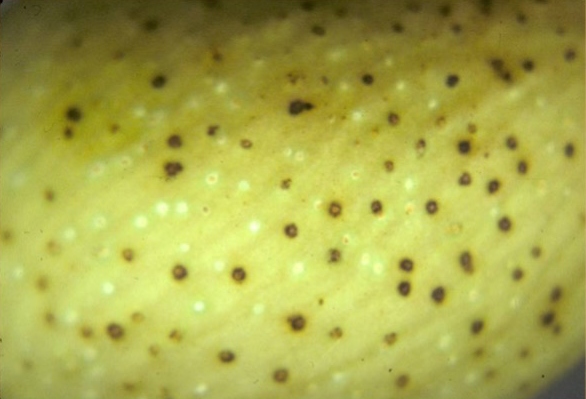
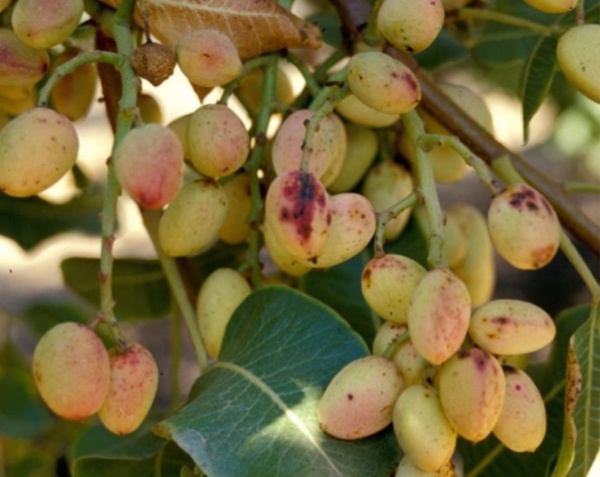
How to differentiate Alternaria from Botryosphere?
As both diseases produce more or less circular brown spots, we might think that we would not know how to distinguish one from the other. However, differentiating them is very simple. Alternaria will produce sporulation in the center of the spots, which will leave our fingers stained if we touch those areas, unlike Botryosphere, which would not leave our fingers dark.
Alternaria control and prevention measures
To control this disease, the best option is to combine the use of fungicides with some management practices, such as:
- Collection of the fruits as soon as they are ripe, since if the fungus is present in them, they will be a source of infection.
- Light pruning to increase aeration inside the tree, with subsequent sealing of wounds.
- Elimination of weeds from the plot to reduce humidity and, in case of having cover crops, it would also be convenient to eliminate it.
- Use drip or buried irrigation in a controlled way, avoiding sprinkler systems.
- In case the infection is serious, stopping watering during the first two weeks of August could also be a good option.
In addition, there are also some organic products that we can use, such as potassium oleate, natural propolis or horsetail.
3.4. Rust
Rust is a disease caused by the fungus Pileolaria terbinthi that is transmitted through the air. Like all fungi, its incidence increases with high temperatures and relative humidity.
What symptoms do pistachios affected by Roya have?
This disease produces necrosis in the leaves, giving rise to brown or reddish spots surrounded by a yellowish border. Over time, these spots darken and become a kind of dust, to end up joining each other.
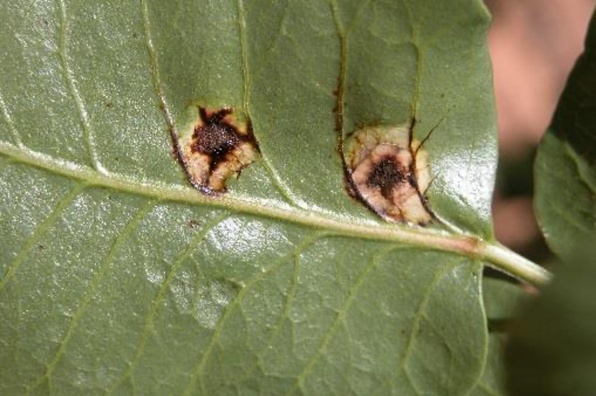
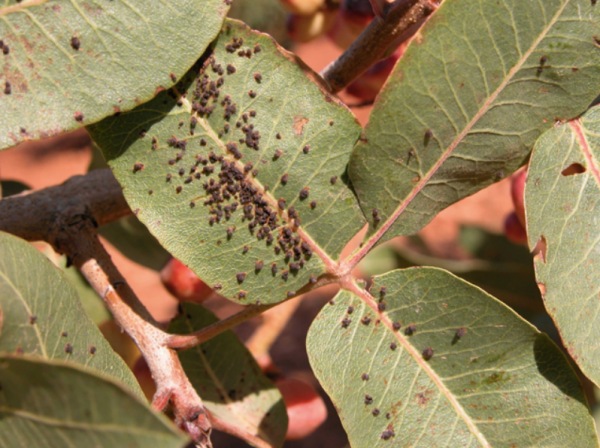
Rust control and prevention measures
- Prune the affected branches, disinfecting the tools correctly between one plant and another, and the subsequent elimination of said branches.
- Removal of potentially infected leaves or fruit, including those that have fallen to the ground, to prevent the disease from spreading
- Carry adequate fertilization, avoiding excess nitrogen and lack of potassium
- Organic products such as potassium oleate or Equisetum arvense can also be used.
3.5. septoria
This disease is caused by the fungi Septoria pistacina, Septoria pistaciarum and Septoria pistaciae. Its activity increases with the rains of late spring and summer.
What symptoms do pistachio trees affected with Septoria have?
The symptoms produced by this disease are reddish-colored necrotic spots that, generally, although time passes, will remain isolated from each other without increasing their size too much. Although, with the passage of time, what will increase is the number of spots.
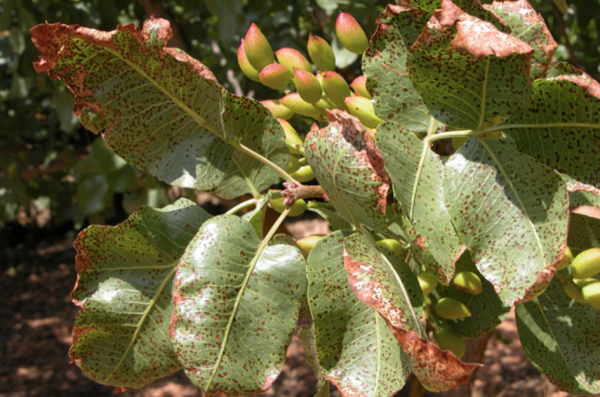
Septoria control and prevention measures
- Pruning of branches with symptoms and removal of fallen leaves and fruits, with the subsequent elimination of all residues.
- As in the case of Rust, carry out adequate fertilization, avoiding excess nitrogen and lack of potassium.
- Applications of copper treatments, potassium oleate or Equisetum arvense.
References
- Couceiro, JF, Guerrero, J., Gijón, MC, Moriana, A., Pérez, D., & Rodríguez, M. (2017).The cultivation of the pistachio (2nd ed.). Mundi-Press. Link on Amazon: https://amzn.to/33Klnwp
- Holtz, B., 2008. Soilborne Diseases of Pistachio. Fruits and nuts, University of California. Available at: http://fruitsandnuts.ucdavis.edu/files/74185.pdf.
- Martín Gil, Á., Arribas Carrasco, G. and Barrios Sanromá, G., 2018. Pistachio Integrated Pest Management. Madrid. Ministry of Agriculture, Fisheries, Food and Environment (MAPAMA). Available at: https://www.mapa.gob.es/es/agricultura/temas/sanidad-vegetal/guiagippistachoweb_tcm30-444529.pdf
- Michailides, T. and Morgan, D., 2004. Panicle and Shoot Blight of Pistachio: A Major Threat to the California Pistachio Industry. American Phytopathological Society. Available at: https://www.apsnet.org/edcenter/apsnetfeatures/Documents/2004/ShootBlightPistachio.pdf
- Michailides, T., 2008. Foliar and Fruit Diseases of Pistachio. Department of Plant Pathology University of California, Davis. Available at: http://fruitsandnuts.ucdavis.edu/files/74186.pdf
- UC-IPM, 2021. Agriculture: Pest Management Guidelines. Pistachio. University of California. https://www2.ipm.ucanr.edu/agriculture/pistachio/ (in English)

![Photo of Olive Tree Cuttings: [Concept, Season, Rooting and Planting]](https://www.complete-gardening.com/wp-content/uploads/2022/08/olive-tree-cuttings-concept-season-rooting-and-planting-390x220.jpg)

